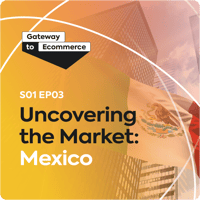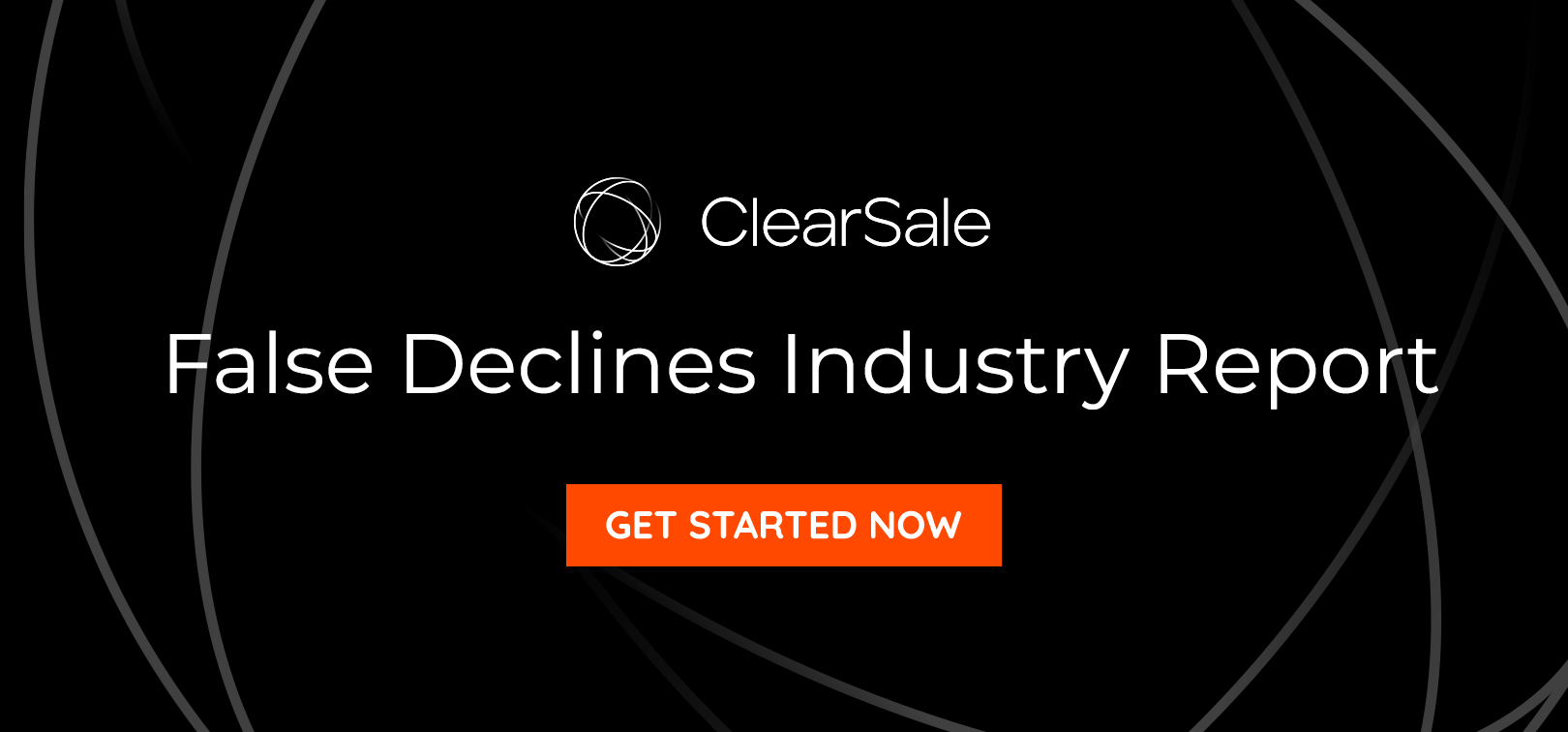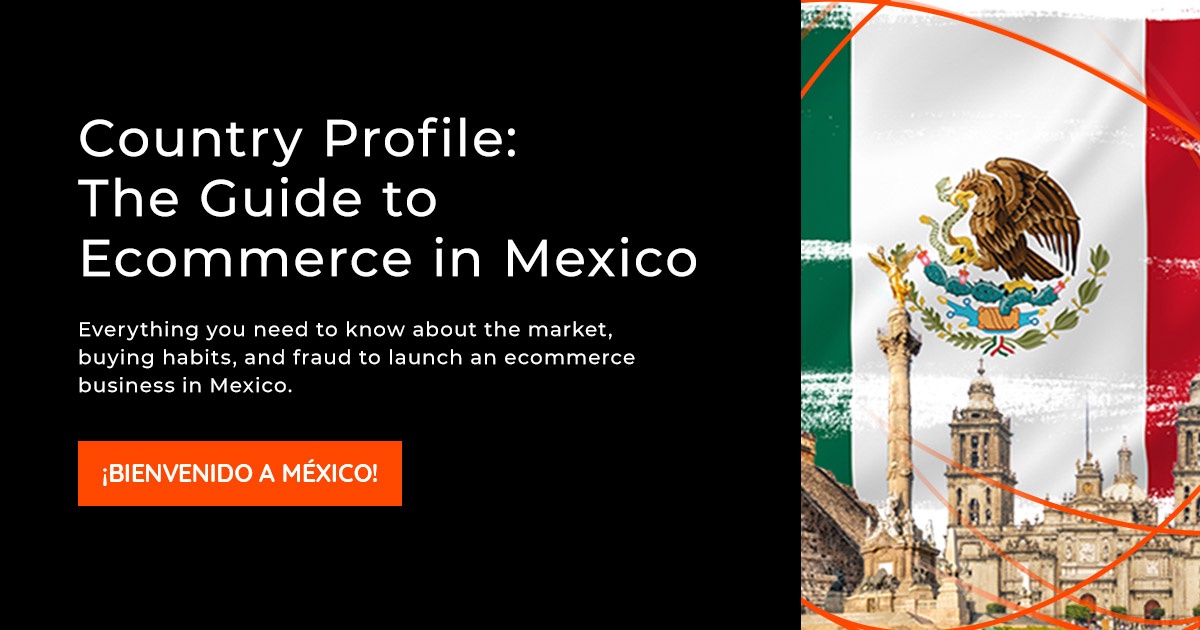episode 03:
Uncovering Mexico Market
Ecommerce merchants are eager to expand their reach to new markets and new customers, but that expansion isn’t without risk.
Before you open for business in another country, there’s a lot to consider, like payment preferences, fraud risk, and shopping habits. Just because you’ve got an active, eager market at home doesn’t mean consumers in a new country will greet you with open arms.
If you’re considering expanding to Mexico — one of the most important markets for ecommerce in Latin America — you’ll want to understand how this market differs from others in terms of fraud and consumers’ unique habits and expectations.
On this episode of Gateway to E-Commerce, Victor Islas, ClearSale’s Mexico country manager, talks with David Fletcher, ClearSale’s senior VP of sales, and Sarah Zilenovski, ClearSale’s senior director of marketing, to share his perspective on the biggest factors for merchants to consider as they explore expanding into Mexico.
.

Podcast Episode Recap
In our third episode, we dive into the unique ecommerce market in Mexico. But first, let’s introduce you to our hosts today:
GO TO SHOW NOTES
Who are your hosts?
-

David Fletcher
is ClearSale’s Senior Vice President. He leverages his extensive ecommerce knowledge to help merchants bridge the gap between the most critical elements of their business.
-

Sarah Elizabeth
is ClearSale’s Senior Senior Director, Growth Strategy (Former Senior Marketing Director). An eight-year veteran of the company who helped open ClearSale’s first full-service branch outside Brazil, she understands the strategies needed for expanding into new markets.
-

Victor Islas
is ClearSale’s Country Manager in Mexico. During his 10-plus years of international experience, he’s helped Latin American companies adopt cutting-edge technology, processes and trends.
Why Can Expanding into Mexico Be Such a Challenge?
It’s no surprise ecommerce merchants are eager to expand to Mexico. It’s one of the most important markets for ecommerce in Latin America and comes in just behind Brazil as the leader in ecommerce sales. And as internet and banking penetration continues to grow here, Mexico presents a unique opportunity for merchants to expand into the Mexican ecommerce market.
But, of course, expansion isn’t without its risks. Right now, there’s still a distrust of shopping online, thanks to high rates of fraud. And Mexican consumers aren’t quick to forgive. Instead, they’ll take to social media to voice their complaints with a merchant or, even worse, will vow to never buy from that merchant again. That means ecommerce merchants must be even more careful about approving transactions and balancing the consumer experience with safety.
What Must Merchants Keep in Mind as They Consider Expanding?
Ecommerce merchants may think that all fraud looks the same, no matter where you’re selling. But there are some important differences that are important to remember as you consider expanding.
• Only 47% of the Mexican population has a bank account, making cash-on-delivery or payments at convenience stores a common payment form that can introduce more risk to merchants.
• Average approval rates hover near 50% due to increased risk.
• Fraudsters in Mexico tend to use common singular last names, like Hernandez, Gonzales or Garcia, making fraudulent purchases harder to identify.
• The banking system in Mexico hasn’t extended its fraud prevention to ecommerce retailers ad shoppers, making purchases risky.
• Complicated addresses in Mexico make it harder for merchants to identify high-risk delivery zones.
• When fraudsters and new ecommerce shoppers have no purchase history, it’s difficult to distinguish between the two.
Preventing Fraud and Growing Revenue
While ecommerce has been risky in Mexico, it’s not a deal-breaker for merchants who are looking to expand. By not auto-declining transactions — and instead manually reviewing them to separate the bad transactions from the good — ecommerce merchants can develop a trusted, lasting relationship with customers. That often means hiring an experienced team of reviewers to confirm that customers are who they say they are.
Another smart strategy is collaboration. By sharing fraud data and information with other markets, you’ll be able to improve your fraud prevention solution’s effectiveness and lower your risk of fraud, false declines, and chargebacks.
Stay tuned for upcoming podcast updates and new episodes.
episode Transcript
Podcast Introduction
You're listening to Gateway to E-Commerce, a podcast by ClearSale. In this series, global ecommerce leaders discuss challenges, best practices, new tech, and secrets to success. And now your hosts, David and Sarah.
David Fletcher
Welcome to today’s episode of Gateway to E-Commerce podcast. I’m David Fletcher, Senior VP of Sales here at ClearSale, and joining me today is Sarah Elizabeth. Sarah is our director of marketing here at ClearSale. Sarah, if you’d like to say hello.
Sarah Elizabeth
Hi. Hey guys, happy to be here.
David Fletcher
Today, we’re going to talk a little bit about Mexico. While ecommerce brings international reach to merchants around the world, it also brings challenges. If you’re thinking about ecommerce in Mexico but you’re not sure where to start, what to expect, or how to prepare—for example, maybe you don’t speak Spanish. (and for me personally, that’s one of my issues I’m still working hard at)—this episode will be able to help you. And helping us today better understand that market is Victor Islas. Victor is a country manager here at ClearSale. Victor, if you would, please say hello.
Victor Islas
Hola, amigos. Hello, everyone. Very happy to be here. And well, I’m glad we are finally talking about a very interesting and dynamic market that is the Mexican one for ecommerce.
David Fletcher
Yeah, so true. True. And some of the things we want to cover today is that we’re going to share some statistics ecommerce merchants should know about the Mexican market. We’re going to talk about Mexican consumers. We’re going to share some of the unique habits and expectations that they have when shopping online. We’re going to talk a little bit about fraud. I know that might surprise you, but we’re going to talk about fraud in Mexico. Although it’s similar to fraud in the United States, it differs. And I think that’s important to understand. There are many things an ecommerce merchant can be doing to avoid fraud and to help increase their revenue in Mexico. And we’re going to talk a lot about that. But let’s start with the market itself, and Victor, this is a great opportunity for you to share with us some information as to the market size, the market opportunities, what it looks like, and so forth. If you would, please share with the audience a little bit about that.
Victor Islas
Okay. Yeah, for sure. One interesting thing that we Mexicans tell each other is that Mexico is probably five years behind the United States in terms of technology. That is a great opportunity for merchants and companies who want to land in Mexico, because we are actually looking forward to accelerating our growth and our knowledge in technology. In terms of ecommerce, Mexico is one of the most important markets for ecommerce in Latin America. We’re just behind Brazil. Brazil leads ecommerce sales with 36.3% of the Latin American market, and Mexico is closing in with 24% of the market. One interesting fact: The Mexican market will be worth $10.1 billion in 2020. It’s becoming an interesting market. And the growth rate of the Mexican market of ecommerce sales is now 16%. and it exceeds Brazil’s growth rate, which is 12%.
I think it’s a very interesting combination of factors that make the Mexican market a very interesting place to invest and to start growing ecommerce, if you have that in mind. One of the interesting facts of the Mexican market: The average revenue per user in the ecommerce market in Mexico is $147. That is 10 times lower than that of the United States, which is $1,568. That is something you have to consider. This factor … I think it’s interesting, especially if you consider that the average income of a Mexican is way lower — probably 10 times lower than the average salary in the U.S. market.
David Fletcher
That’s a great point, Victor. I was actually going to ask you if you thought that was because of the difference in income per individual or is it tied to the fact that the Mexican market is behind a little bit on the ecommerce side?
Victor Islas
Yeah, I would say both things. It’s a matter of maturity, but also, there is a matter of the difference in income. Life in Mexico can be way cheaper than life in the United States. If you go to the supermarket to buy food, it’s going to be way cheaper in Mexico than it is in the United States. Probably renting houses is also cheaper. Life, in general, is cheaper if you market in U.S. dollars but also with incomes, but I believe this growth that we’re talking about, 16%, will actually increase the average revenue per user, per year in the following years. I’m pretty confident about that. We have been watching how the Mexican market is growing, not only in the average revenue per user, but also in the number of people who are actually giving a try to ecommerce. Well, we have now the COVID and people staying at home, and this is creating a lot of changes in the market.
Victor Islas
Well, Mexico has a lot of potential, but yeah, it has a lot of challenges. And the idea of these podcasts is to share some of our insights and knowledge on entering the Mexican market. First of all, when we’re talking about ecommerce, we should be talking about the low internet penetration. Compared with internet penetration in the United States and Europe, the penetration of the internet in Mexico is very low. Probably the phones, the mobile phones, are helping to manage or is helping to have more penetration of ecommerce, but one of the other factors — and probably one of the most important ones — is that only 47% of the Mexican population has a bank account. The penetration of banking is still really low. And that for sure is a big, big challenge for understanding the Mexican market.
When you’re talking about ecommerce in Mexico, you’ve got to think about the convenience store. Actually, the 7-Elevens and the corner shops have become an important part of actually collecting and being able to complete the circle of payments in ecommerce. There is still a big percentage of the population that is going and paying in these convenience stores in order for them to receive their products. That is important.
And also, the mentality of ecommerce shopping. We have numbers that say that 25% of the people actually prefer the in-store experience. And 23% say they don’t trust online shopping. I think this is very important, because one of the things that makes the Mexican market very risky is the mistrust we have in new ways of shopping. And that is due to fraud. And the reason is that typically, Mexicans have to cancel their credit cards two or three times per year because their credit cards have been cloned. That is an important factor. And even though these cards may be cloned in a restaurant or in a physical store, shoppers tend to mistrust online shopping. And that is a very interesting factor.
Sarah Elizabeth
That’s really interesting. We have some similar stuff with Brazil on the fraud side — of course, not on the banking side, because Brazil has one of the most advanced banking systems because of fraud in the past and because of high inflation — but I get what you’re saying. It’s being a Brazilian. We have some similarities as well.
There’s another thing that I find really interesting about the Mexican market. We have done a survey with five different countries, including Mexico. And we found out that for Mexicans specifically, they are really resentful markets. For instance, if they have a transaction declined by a merchant, there is a 40% chance they are going to post on some social platforms. There are some negative comments on social media. Sorry, Whitney. When looking at the impacts that we see of fraud and declines on the Mexican behavior, we see that 5% of Mexicans will post a negative comment on social media if they have a transaction declined. And for about 50% of Mexicans, if they have a declined payment, they will never buy with that merchant again. We see that it’s a market with lots of challenges and also a resentful market, which makes merchants have to be more careful when dealing with customers in this market.
Ready to Conquer Mexican Ecommerce?
Victor Islas
Yeah, absolutely. Absolutely. Mexicans tend to be resentful and to remember this stuff, and this is a great risk and a great challenge and, of course, a great opportunity for merchants to grant the best experience in terms of approval rates. These may be very surprising to you, especially if you’re based in the United States or in Europe, where probably approval rates are around 95%. You may be surprised that in Mexico, probably average approval rates are around 50% or 55%. That means that five of every 10 people that try to shop online, are being declined because of risk.
One of the interesting factors and challenges granting the best experience for customers, as you mentioned, is that Mexican shoppers may be resentful. And one of the biggest challenges is that opportunities for the new merchants arriving in the Mexican market is actually approving more customers. You may be surprised, especially if you’re in the United States or in Europe, to hear the average approval rate in Mexico is 50%, compared to 95%, 96%, 97% that the U.S. market has. Five of every 10 people who want to do an online purchase are being declined because of fraud or because merchants don’t have the right tools to identify good and bad customers. It is very normal that whenever I speak to customers or to merchants, I hear that they are fighting and they are really suffering and struggling on increasing their approval rates above 55%, 60%. That is mind-blowing, especially if you’re not used to dealing with the Mexican market.
David Fletcher
Victor, let me ask you, in our experience that we’ve had together with ClearSale and working in the Mexican market, one of the biggest things that I quickly learned was there’s a big difference between the banking process, the gateways, and fraud prevention in Mexico. And I think this’ll be a great opportunity for you to share a little bit more information about that, so that we can help our listeners better understand how different it really is in Mexico.
Victor Islas
Yeah, for sure. If you’re talking about ecommerce in Mexico, one of the biggest challenges and one of the biggest opportunities is the banking system. Probably Sarah mentioned, previously in Brazil, there used to be a lot of fraud. And that is the situation in Mexico, where fraud was not only in ecommerce but also in the physical world. Right now, the banking system in Mexico is really focused on preventing fraud in the physical stores. And they have brought really interesting mechanisms to prevent fraud for retailers. But in the case of ecommerce, they’re still not mature enough. They don’t have specific solutions for ecommerce merchants. They don’t fully understand what are the particularities and the needs of the ecommerce market. And they haven’t come up with specific solutions for ecommerce.
What the ecommerce industry and merchants have been trying to do is trying to adapt their solutions and their checkout flows to the needs or to the solutions that are available in the market that are not always thought for ecommerce. One of the things that you should be looking forward at is to build a specific flow based on the actual solutions available by the banking system. One of the main factors is that typically, banks penalize merchants for everything that they do. If they reimburse, they are penalizing. This may be surprising, but when you want to reimburse a transaction, it may take up to 30 days. Merchants are actually receiving chargebacks from orders that they reimburse, but the banking system took 30 days to do the reimbursement. There is a chargeback in this period, and that makes things complicated.
Typically, what we do and what we focus on is helping our customers and merchants think about a specific flow that allows them to accept more good customers and actually prevent chargebacks. But it has become a very complex solution about where you start. When you need to involve developing teams and you need to be very well-communicated with your bank and with your fraud solution. And talking about that, one of the particularities and interesting things about the Mexican market, is that typically, Mexican merchants tend to be lazy. They tend to use something that we call aggregators or PayPal, which make life easier for them as merchants, as an all-in-one solution. And I think one of the great opportunities for new merchants is to try to find better solutions than the ones that are available.
If you come to a Mexican market, you will certainly be ahead of this if you start building your own solutions with an actual bank and your own anti-fraud solution rather than having these aggregators that offer all-in-one solutions, but they tend to have approval rates around 50%. And that is very dangerous if you’re in ecommerce — declining half of your purchases.
David Fletcher
Yeah, no doubt. And Victor, that’s interesting because of the fact that these banks are trying to basically protect themselves and the merchant by declining so many orders. It ties right into what Sarah shared earlier with the resentful market — that if the buyer is declined, over 50% of customers will never order from that merchant again.
Victor Islas
Yeah.
David Fletcher
It’s so harmful to these merchants in your marketplace when this is happening.prevention strategy.
Victor Islas
Yeah, absolutely. That is one of the things that I try to talk to these merchants about. And in Mexico, I see two different scenarios. We see the topic ecommerce in which we can talk about Amazon, Walmart, Liverpool — merchants that are doing things in an amazing way. They have been working very hard in having their own fraud solution and having their own payment solution. These guys are approving over 85%, 90% of the purchase attempts — compared to the rest of the market that is approving only 50% of the purchase attempts. That is a completely different scenario. And when I talk to them, I tend to tell them, “Hey, if you’re declining the customer, you’re losing not only the value of that purchase, but also the customer lifetime value. And probably this customer will end up shopping in Walmart and in Amazon. Every investment you made in social media, in remarketing, to bring this customer to your site, and then when he tries to purchase, you’re declining him. You are investing to bring customers to Amazon and to Walmart and to Liverpool. You’re actually doing the job for them.”
That is very helpful for them to understand why these ecommerce merchants that have invested in a robust solution of fraud prevention and payments are actually growing more than the rest of the merchants.
David Fletcher
Awesome.
Sarah Elizabeth
Victor, thank you for sharing all of this knowledge. It’s really interesting to hear all of that. And being someone who moved from another country to the United States, I saw with my own eyes that there are many things that are different about the behavior of people when purchasing, depending on the country that they are in. Are there any other aspects that you see that are really different in Mexico versus not only the United States, but also the rest of the world, that you think is important to highlight for the merchants?
Victor Islas
Yeah, of course. Well, one of the most interesting facts is whenever you arrive to the Mexican market is the payment methods. As we talked about at the beginning, the banking penetration is low and you will see that probably, debit cards are way more used than credit cards. We have information that says that probably 84% of the purchases have been done through debit cards at some point and credit cards is way lower than that. That is something to consider. And as I mentioned at the beginning, there are different or alternative payment methods that have been very successful in the market.
One of them is cash on delivery, and probably 67% of the people who have done a purchase have actually tried this method. This is a great method for starting and growing confidence with your customers. Typically, customers will ask for an order to be cash on delivery and probably on the second or third order, actually, they will move to credit card or debit card once they have trust in the merchant.
And the second one — and we talked about it in the beginning — was the convenience store payment. And when I talk to customers, I tend to tell them that they need to have an option, either cash on delivery or payment in convenience stores like 7-Eleven or different corner shops, because this will allow first-time shoppers to start gaining trust in the merchant. I believe this is a must for the Mexican markets and, of course, they can always complement with e-wallets like PayPal express checkout, which will actually help them to start building trust with the customer. As we saw, we have a very resentful market but also a very loyal market. Whenever you’re able to gain the trust of your shopper, you will have a very recurrent customer. And compared to that, probably only 20% of the market considers themself a recurrent buyer, compared to the United States, which may go up to 70%. But this is a number that we will see an important growth within the following years.
David Fletcher
Yes, Victor, that is so true. And it’s funny that you mentioned that, because I can tell you firsthand, that’s the American buyer mentality — those subscriptions and that recurring purchase. And that’s becoming more and more popular. And we haven’t seen that in Mexico as much, so great information.
Moving on in talking about fraud, which we have a little bit of experience in, fraud can be somewhat similar between the United States and Mexico, but there are definitely things that our fraud analysts look for in Mexico that are a little bit different. And I think it would be great, Victor, for you to share with our audience a little bit more information. These are great tips, and this is some insight that we can share. And it’s based on experience, because one of the things that we tell everyone is we’re looking at other countries and we’re talking about our merchants as they’re moving into other regions and into other countries. It’s different. And what that means is, it’s not a one-size-fits-all. We don’t create this algorithm and say, “Hey, here it is. Now we can prevent fraud all over the world.”
That’s not accurate. It is different in every region, and for a number of different reasons, it is different. But I think this would be a great opportunity for you to share some of the tips there that our fraud analysts in Mexico are looking out for.
Victor Islas
Yeah, for sure. The average chargeback rate in Mexico — and this is a report by Visa — is at 2.2%. If you compare to that 0.4% average chargeback rate in the United States, that is a different story. And let’s take it this way: If you’re selling electronics, probably you have an 8% margin. Losing 2.2% in chargebacks directly affects your margin. That is a very important consideration that you should have in the Mexican market. That explains a lot why merchants and these payment aggregators are being so cautious. They’re giving 50% approval rates because they want to lower these 2.2% chargeback rates that we have in the market. Just to start giving some details if you’re really thinking about investing in Mexico and start operating here. Well, there are some very particular factors that I’m going to mention that probably will help you understand and prevent fraud, which is, as you mentioned, our main expertise in the market, especially in Latin America.
The first one is the lack of a second last name. Different than in the United States, in Mexico, people use their two last names — the father’s name and the mother’s last name. Typically, we tend to see that with people who use two surnames, transactions are safer than with transactions with people who just use one last name. And you have to be careful about the common last names, such as Hernandez, Gonzalez or Garcia. You have to watch these last names, because they tend to be very common and they tend to be used by fraudsters.
Of course — and this applies to Mexico specifically — watch out for recently created emails. And watch out how these emails are built. This can tell you a lot about the nature of the transaction.
Of course, we’re seeing a lot of frequent purchases on high-risk products. Typically in Mexico, the regular regulations for legal on the prosecution are very low. That is something that’s very common — seeing high-risk products being purchased one after another. And, of course, the delivery address as well. This is very interesting and very important. In Mexico, you can see and you can understand fraud by understanding the delivery addresses. This is something that every merchant should watch out for. Also, the addresses tend to be very complicated. There are some areas outside of the bigger cities where delivery addresses are very complicated. And typically, these are high-risk zones for the merchants.
One of the other things that you should look out for is the lack of purchase history. And of course, if you’re building your anti-fraud solution in a collaborative system, this will help you to make better decisions. This is something important. And actually, it’s one of the factors that we help our customers with through collaboration. That has been proven to be one of the most important factors on helping the whole industry make better decisions, increase sales, and prevent fraud.
And the last one is to watch out for the IP addresses that are located in different states from the billing and delivery addresses. This is something that’s very common. And a funny story, I have run myself into different providers in social media, especially on Facebook and on Twitter, that they claim to have special discounts. These providers, they claim to have special deals or discount rates with different ecommerce merchants. They tell you that you just have to pay 50% of the actual cost of the product and they will deliver it home. This is a very challenging situation, because you have fraudsters receiving money from outside and sending to different addresses. That’s more complicated for an anti-fraud solution to start identifying these prevalent purchase patterns.
Sarah Elizabeth
What is interesting here is those are great tips, but we also always have to remember that it’s not black and white. These are alerts that we have taken into consideration, but we always have to go back to the false decline issue that we were mentioning before — that we cannot simply decline a transaction because they have one or multiple alerts. What we usually do here at ClearSale, we send them to many reviewers. We have some analysts who are located in Mexico and are specialized in the market that review these transactions and make the final decision. These are great tips, but I always have to remember that we have to give an opportunity to any transaction. We always give a second chance for them to prove that they are legit.
Victor Islas
Absolutely. Yeah, it’s one of the things that happened, and I’ve spoken to people who have started working in Mexico and they come from the United States, and every transaction in Mexico seems to be risky, right? Compared to the U.S. market, every transaction is riskier. If you actually look for the address in Google maps, probably you will be declining 80% of the transactions, right? All of them seem to be risky, but I strongly believe — and as you mentioned, Sarah — the key for being successful in the Mexico and Latin American markets, one of them is not automatically declining. That is one of the biggest mistakes, because as we mentioned, probably all of the transactions may seem risky if you are coming from the United States, right?
The second one is using leveraging on a collaborative system. If you have your own data and you’re working on it, that’s great. But actually, if you want to excel, having a collaboration model in which you can share data and information with other merchants, you will have better results.
And third, as a consequence of not automatically declining is using a manual review or a manual analysis team to check on these risky orders, in order to try to actually say those who are rightful shoppers.
Learn What This Fraud Analyst in Mexico Has to Say About the Market
David Fletcher
Victor, thank you so much for helping us out today and sharing some of these insights. As we start to wrap up, I think it’s important to remember that a fraud solution is critical for doing business in Mexico.
Victor Islas
Absolutely.
David Fletcher
Not only is it a crucial part of your business, but we also have to be careful that you’re not overzealous about preventing fraud, because that already exists. And that’s why the false decline rates are so high. Legitimate buyers are getting swept up in the process, but they’re getting turned off of your brand forever because of this high rate of false declines. And we already know the latest data has shown us false declines will grow to cost businesses $443 billion worldwide by 2021. Surprisingly, this vastly outweighs the losses from fraud itself. This is a global problem that we need to really be focused on.
If you’d like to know more about preventing ecommerce fraud, please visit our website. We have so many resources available there for you to help you out in your ecommerce journey. Our website is www.clear.sale. If you have any questions or you’d like to suggest a topic that you’d like us to cover, please send us an email. You can reach us at podcast@clear.sale. Again, thank you for listening to the Gateway to E-Commerce podcast, where global ecommerce leaders discuss the challenges, best practices, new technology and secrets to success. We’d love to have you subscribe to our podcast. You can subscribe to our podcast on Apple Podcasts, Spotify or Google Play. And of course, please leave us a review. We would love to get some feedback. We’d love to hear from you.
Join us for our next episode, which is episode four, where Denise and Sarah will continue to discuss ecommerce fraud. Sarah, thank you. Victor, thank you.
Sarah Elizabeth
Thank you.
David Fletcher
And with that, we’re signing off.
Podcast Outro
For more ecommerce insights, visit us on our website at clear.sale.










![[webinar] Route & Midigator](https://no-cache.hubspot.com/cta/default/2530812/85a38412-9a58-4304-ab50-50dc69542fb7.png)



